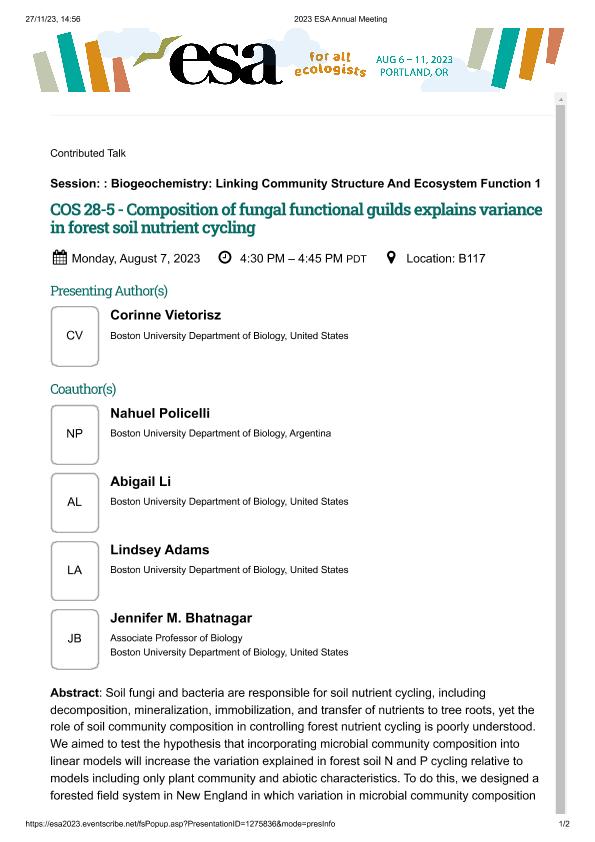Mostrar el registro sencillo del ítem
dc.contributor.author
Vietorisz, Corinne
dc.contributor.author
Policelli, Nahuel

dc.contributor.author
Li, Abigail
dc.contributor.author
Adams, Lindsey
dc.contributor.author
Bhatnagar, Jennifer M.
dc.date.available
2023-11-27T17:57:15Z
dc.date.issued
2023
dc.identifier.citation
Composition of fungal functional guilds explains variance in forest soil nutrient cycling; ESA 2023 - Meeting of the Ecological Society of America; Portland; Estados Unidos; 2023; 1-2
dc.identifier.uri
http://hdl.handle.net/11336/218615
dc.description.abstract
Soil fungi and bacteria are responsible for soil nutrient cycling, including decomposition, mineralization, immobilization, and transfer of nutrients to tree roots, yet the role of soil community composition in controlling forest nutrient cycling is poorly understood. We aimed to test the hypothesis that incorporating microbial community composition into linear models will increase the variation explained in forest soil N and P cycling relative to models including only plant community and abiotic characteristics. To do this, we designed a forested field system in New England in which variation in microbial community composition was crossed with variation in vegetation composition and soil nutrient content. At six forest sites (three suburban and three rural sites), we sampled soil along a transect from the forest edge to interior from four stand types dominated by trees of varying litter quality: pine-dominated, pure hardwood, hardwood with pines in the understory, and mature mixed pine-hardwood. In each soil sample, we measured inorganic and total nitrogen (N) and phosphorus (P), N and P mineralization rates, and nitrification rates. We also performed high-throughput sequencing of fungal and bacterial rDNA amplicons (16S/ITS) and calculated functional guild abundance for fungi and bacteria in each sample. Excluding microbial factors, N mineralization was best explained in a linear model by pH, soil temperature, soil moisture, % soil organic matter, and the abundance of understory vegetation; nitrification was best explained by pH, the proportion of hardwood litter, the abundance of understory vegetation, and basal area of arbuscular mycorrhizal-associating trees. We found that including the proportion of fungal functional guilds improved linear statistical models explaining variance in rates of N mineralization and nitrification, but not in single point measurements of inorganic N or total P. The proportion of ectomycorrhizal fungi per sample was positively related to N mineralization (p = 7e-05, R2 = 0.128), and including it in the model increased the proportion of variance explained in N mineralization rates by 2.8%. The proportion of saprotrophic fungi per sample was positively related to nitrification (p = 0.001, R2 = 0.083), and including it in the model increased the proportion of variance explained in nitrification rates by 2.0%. These findings suggest that ectomycorrhizal fungi may play a role in N mineralization, while saprotrophs may be more important for nitrification. We are currently building models to explain P mineralization and to improve current models by incorporating bacterial functional guilds.
dc.format
application/pdf
dc.language.iso
eng
dc.publisher
Ecological Society of America
dc.rights
info:eu-repo/semantics/openAccess
dc.rights.uri
https://creativecommons.org/licenses/by-nc-sa/2.5/ar/
dc.subject
CARBON CYCLING
dc.subject
ECTOMYCORRHIZAL FUNGI
dc.subject
SOIL MICROBES
dc.subject.classification
Ecología

dc.subject.classification
Ciencias Biológicas

dc.subject.classification
CIENCIAS NATURALES Y EXACTAS

dc.title
Composition of fungal functional guilds explains variance in forest soil nutrient cycling
dc.type
info:eu-repo/semantics/publishedVersion
dc.type
info:eu-repo/semantics/conferenceObject
dc.type
info:ar-repo/semantics/documento de conferencia
dc.date.updated
2023-10-25T10:04:34Z
dc.journal.pagination
1-2
dc.journal.pais
Estados Unidos

dc.journal.ciudad
Portland, Oregon
dc.description.fil
Fil: Vietorisz, Corinne. Boston University; Estados Unidos
dc.description.fil
Fil: Policelli, Nahuel. Consejo Nacional de Investigaciones Científicas y Técnicas. Centro Científico Tecnológico Conicet - Centro Nacional Patagónico. Instituto Patagónico para el Estudio de los Ecosistemas Continentales; Argentina. Boston University; Estados Unidos
dc.description.fil
Fil: Li, Abigail. Boston University; Estados Unidos
dc.description.fil
Fil: Adams, Lindsey. Boston University; Estados Unidos
dc.description.fil
Fil: Bhatnagar, Jennifer M.. Boston University; Estados Unidos
dc.relation.alternativeid
info:eu-repo/semantics/altIdentifier/url/https://esa2023.eventscribe.net/
dc.relation.alternativeid
info:eu-repo/semantics/altIdentifier/url/https://esa2023.eventscribe.net/fsPopup.asp?PresentationID=1275836&mode=presInfo
dc.conicet.rol
Autor

dc.conicet.rol
Autor

dc.conicet.rol
Autor

dc.conicet.rol
Autor

dc.conicet.rol
Autor

dc.coverage
Internacional
dc.type.subtype
Encuentro
dc.description.nombreEvento
ESA 2023 - Meeting of the Ecological Society of America
dc.date.evento
2023-08-06
dc.description.ciudadEvento
Portland
dc.description.paisEvento
Estados Unidos

dc.type.publicacion
Book
dc.description.institucionOrganizadora
Ecological Society of America
dc.source.libro
Meeting of the Ecological Society of America
dc.date.eventoHasta
2023-08-11
dc.type
Encuentro
Archivos asociados
